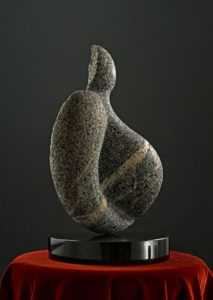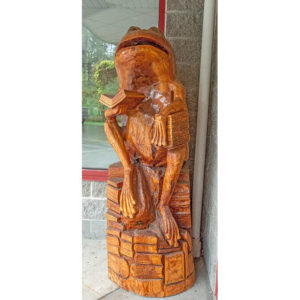Vinay watched
me work for a while the other
day in my studio. I knew he was coming,
but I didn’t notice him coming in. I didn’t notice
anything, really, but the granite boulder I was carving
with a big, loud, pneumatic hammer and a 9-point
bushing chisel. It bucked like a bronco, and all I
could do was dance with it, guiding the
action but not controlling it.
Rivers
of sand rolled off
the rock, dust was in the
air, and I, ecstatically,
was into it.
Even after
I noticed him, I kept at
it til I was out of breath and
my arms ached so bad they wouldn’t
work right anymore. We stepped outside,
took off our masks and muffs, I enjoyed a
shake, a stretch, a breath of air, and a
great conversation with my col-
league before plunging
back into the dust
cloud.
What is it going to be?
That simple
query initiated our discussion
and I couldn’t answer it. I couldn’t even
get started. I can’t count the number of
times I’ve been asked that, or how
often I’ve not known
what to say.
Sometimes I do
know what to say. “It looks like
a bird looking up”, I said of one of thousands
of boulders on a beach one day. Then
I took it home and carved
it: Looking Up.

But
that doesn’t happen
very often.
What could I
have seen “in” The Gift when it
was one of many? A 3D form attracted
my attention and drew me in, simply as an
interesting form at that stage, and not
as anything else.

No way. I
can’t even imagine having
imagined what it might have “been”,
back then at the beginning. I
can’t imagine it even
now.
I imagined
something in a cobble on
a beach, imagined it for years in
my stoneyard, imagined it while
I carved it and still do. But
I don’t know what
it is!
We named
The Gift for its base, which
I designed to look like a gift box.
The idea was to hint that the
sculpture, whatever it is,
may have come in
that box.
The stone I’m
carving now rested in my
stoyeyard for several years, just
as you see it at the top. Then, a
few weeks ago, I began
to carve it.
Now, it could
still be three different sculptures,
identical in every way but one of them
oriented “right side up”, one “upside
down”, and on its back, like
in the picture.
Their forms
would be identical, but their
orientations would suggest different
things, carry different meanings, evoke
different thoughts and emotional responses
from visitors to my workspace, and
present different challenges in
sculpting it in stone.
One of those
sculptures is a hooded woman’s
head, contemplative, observant, looking
outward and downward. Another is the same
woman’s torso, probably pregnant, still con-
templative, still observant, still looking
out and down. On its back it
is a baby.
It is a certain
shape now, it will be a certain
shape when it is finished, and it may
never be anything other than a
certainly-shaped boulder.
When Vinay
asked the question, I wasn’t
ready to imagine a final product. I didn’t
want, even silently and tentatively to myself,
to name it. I was still discovering its beginnings.
I used a neutral, noncommittal, purely geo-
metric working title to speak of it:
“Three Surfaces”.
To have
tried to answer Vinay’s
question would have put me far
ahead of where I was at the time, so I
flopped the boulder around on its sandbags,
to show him the 3 and only 3 possible
orientations. We discussed their
promises and challenges,
sculptor to sculptor,
and let it go at
that.
At that early
stage, I felt no need to reduce
uncertainty about the ending by commit-
ting to orientations, meanings, or
labels. It was too soon for
that, and I resisted
my tendency
to rush
it.
Vinay’s question
was enormously useful to me.
Talking with him about it clarified
what the sculpture actually
“was” for me at the
time.
Clarifying what
it was freed me to think about
what it might be. That in itself
moved me closer to deciding
the orientation.
Now,
a few days later,
2 of those 3 possibilities
are fading fast and one
is standing out
as likely.
So thanks, Vinay,
for the question I didn’t answer.
Sculpting works better for me when I don’t
decide, and that’s true on many levels. If I keep
not knowing quite where I am headed, I keep finding
things to do. I do higher quality work that is more
meaningful to others and more interesting, en-
gaging, and exciting for me to do. It’s more
fun and more productive to discover
what a rock will become than to
decide what it will be
ahead of time.
It may sound like
I have serious commitment
issues, and that may be true. But
I don’t think it explains my avoiding
saying what sculptures ‘are’ or what
they ‘will become’ until I’ve finish-
ed discovering that. Even then,
I sometimes prefer for
others to do the
naming.
To a great extent,
my work is much more about
discovering forms than it is about making
meaning or representing things. My sculptures
do acquire meaning, later, at least for me – –
meaning that can be represented by
names, like Looking Up. But
few of them are born
with it.
Meaning emerges,
for me and into me, through
the work of carving stone. Fantasies
and bodies play with forms and
stones, and meaning grows
out of the process.
At some point
in the process, usually at the
end, a title and all it implies might
or might not appear. When it does I
call sculptures things like The Granite
Madonna. When it doesn’t, or I
don’t want to for one or more
reasons, I call them The
Gift or Waveform
2019.
What IS in a name?
I know it’s not
like that for all sculptors
or all artists, but it seems to
be that way for me.

In Mark Wunsch’s film
The Granite Madonna, the sculpture
rotates in this light.
Vinay Chafekar’s
sculptures mean something
from before their beginning. His
large, whimsical. chainsaw sculpture
RRReadit – RRRead it, a frog
reading a book, graces the
Quadra Island Library
in Quathiaski Cove.
It won first prize
in the Shoreline Arts chainsaw
carving competition, amateur division,
in Campbell River. A lovely soapstone
sculpture of \his, carved in the same
year, is similarly symbolic:
it is a sculptor carving
himself out of
stone.
He plans sculptures
with care to incorporate symbols
and multiple layers of meaning. His works
are beautiful, they make me think, and the sign-
ificance of their forms maps directly, precisely, and
clearly into language. Those sculptures tell stories
about language and meaning, about the signifi-
cance of language to children, and of sculpt-
ing and reading and language and
meaning to Vinay himself.
Their messages
are clear and unambiguous.
Their symbols are rich allegorically
and communicate, clearly,
the intent of the work.
I love them!
In Help!, I
describe a somewhat
later stage of development of
The Granite Madonna, after I had
chosen the orientation in general but
before I had decided the precise,
balancing, vertical for the
hole that would freeze
it that way for-
ever.
Later than that,
still before completion, I used
The Granite Madonna to illustrate
the importance of lighting in
viewing sculpture in
To Visualize a
Stone.
Gregory Bateson
insisted that “the name of the
thing is not the thing”, and discussed
Korzybski saying earlier that “the map
is not the territory”. In an significant
sense, the issues I explore in this
story live where those ex-
pressions come
together.
Antonio Machado’s
poem Caminante
No Hay Camino
also comes
to mind:
“~Walker,
there is no pathway.
You make the pathway
while you walk.”
First published in the Vancouver Observer.
Edited March 2021



